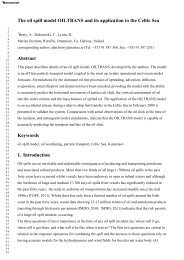Marine Industries Global Market Analysis - Marine Institute
Marine Industries Global Market Analysis - Marine Institute
Marine Industries Global Market Analysis - Marine Institute
You also want an ePaper? Increase the reach of your titles
YUMPU automatically turns print PDFs into web optimized ePapers that Google loves.
MARINE INDUSTRIES GLOBAL MARKET ANALYSIS<br />
107<br />
20 Shipbuilding<br />
1999–03 2004 2005–09<br />
Irish <strong>Market</strong> €M 2 0 2<br />
UK <strong>Market</strong> €M 1,001 234 928<br />
Europe <strong>Market</strong> €M 63,913 13,143 52,076<br />
World <strong>Market</strong> €M 183,440 37,746 155,017<br />
Definition – total capital value of ships =>100GRT. Excludes naval vessels.<br />
20.1 INTRODUCTION<br />
The world shipbuilding industry is currently enjoying a strong upturn due to the<br />
major growth in demand for shipping discussed earlier.World economic growth is<br />
buoyant and it is expected to remain so in the medium term boosted by the very<br />
strong growth of the Chinese economy and, to a lesser extent, that of other<br />
developing economies.World seaborne trade has increased with exports of<br />
containerised goods and imports of commodities such as oil & steel.The commercial<br />
shipping industry has become more profitable than at any time during the previous<br />
decade and ship-owner confidence has grown.The overall result has been a surge of<br />
orders for vessels and yards currently have full order books, newbuild tanker prices are<br />
up by 40% and average delivery time extended from two to three years. 69<br />
It is unlikely that such high economic growth rates can be sustained and in 2007–8<br />
we expect a return to more normal activity levels as the new tonnage is absorbed by<br />
the market. As a result, many shipyards are not adding further capacity. Shipbuilders’<br />
profits have been hit by a combination of a large rise in steel prices and a fall in the<br />
US$. A result is that South Korean yards are reported to be targeting fewer orders in<br />
2005. 70 For over a decade the prices of newbuilds has been on a downward trend.The<br />
1990-based US$ index had fallen by 50%, mainly due to chronic overcapacity<br />
resulting from government subsidies, often attacked by the EU to little effect. 71<br />
A resumption of the lower long-term growth trend is, however, likely in the<br />
foreseeable future. From some $35 billion in 2000, we expect the total value of<br />
shipbuilding output to peak at around $45 billion in 2004–2006, and then fall to<br />
$39bn in 2008 before returning to its underlying long-term growth trend. However,<br />
as shown in an earlier chart, the recent major variations in the euro/dollar exchange<br />
masks this dollar market rise.<br />
The industry has, over the longer term, produced an average of some 1,800 vessels<br />
per annum. Notable changes in the market have included a trend towards larger<br />
vessels, especially container vessels and tankers.We believe that this will continue but<br />
will not appreciably affect the average size of new vessels constructed during our<br />
forecast period.<br />
There has been a growth in average vessel size and we may well see 10,000+ TEU<br />
container vessels before 2008 but their numbers will be small.<br />
69<br />
‘Lloyd’s List’ Annual Review 30 December 04.<br />
70<br />
‘Lloyd’s List’ 5 January 2005, p1.<br />
71<br />
‘Report from the Commission to the Council on the Situation in World Shipbuilding’, Commission of the European<br />
Communities, 2003.http://europa.eu.int/comm/enterprise/maritime/

















